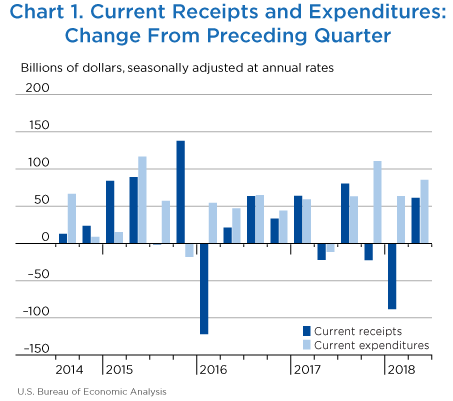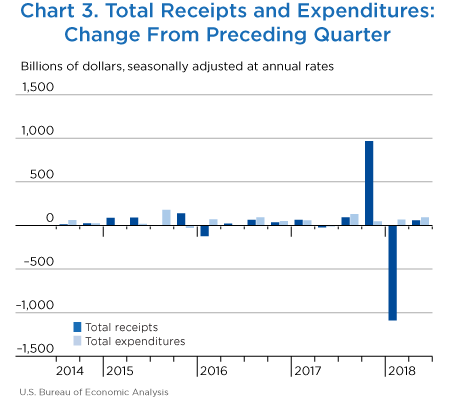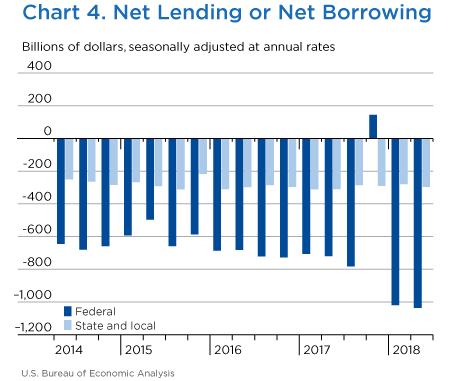Government Receipts and Expenditures
Second Quarter of 2018
Net government saving, the difference between current receipts and current expenditures in the federal government and state and local governments, was −$1,224.3 billion in the second quarter of 2018, decreasing $24.1 billion from −$1200.2 billion in the first quarter of 2018 (charts 1 and 2 and table 1).
“Net lending or net borrowing (−)” is an alternative measure of the government fiscal position. Net borrowing is the financing requirement of the government sector; it is derived as net government saving plus the consumption of fixed capital and net capital transfers received less gross investment and net purchases of nonproduced assets.
Net borrowing was $1,333.0 billion in the second quarter, increasing $33.3 billion from $1,299.7 billion in the first quarter (charts 3 and 4 and table 1).
| Line | Level | Change from preceding quarter | ||||
|---|---|---|---|---|---|---|
| 2018 | 2017 | 2017 | 2018 | 2018 | ||
| II | III | IV | I | II | ||
| 1 | Current receipts | 5,474.4 | 80.2 | −22.6 | −88.3 | 61.3 |
| 2 | Current expenditures | 6,698.7 | 63.1 | 110.6 | 63.5 | 85.3 |
| 3 | Net government saving | −1,224.3 | 17.1 | −133.2 | −151.7 | −24.1 |
| 4 | Federal | −984.5 | 1.0 | −143.1 | −166.3 | −14.6 |
| 5 | State and local | −239.8 | 16.2 | 9.8 | 14.5 | −9.4 |
| 6 | Net lending or net borrowing (−) | −1,333.0 | −38.4 | 920.6 | −1,153.4 | −33.3 |
| 7 | Federal | −1,036.5 | −62.4 | 925.8 | −1,164.0 | −16.7 |
| 8 | State and local | −296.5 | 24.0 | −5.2 | 10.6 | −16.6 |
Net federal government saving was −$984.5 billion in the second quarter, decreasing $14.6 billion from −$969.9 billion in the first quarter (table 2). In the second quarter, current receipts turned up, and current expenditures decelerated.
Federal government net borrowing was $1,036.5 billion in the second quarter, increasing $16.7 billion from $1,019.8 billion in the first quarter. The volatile pattern of net borrowing in recent quarters reflects the impacts of various provisions of the 2017 Tax Cut and Jobs Act (TCJA). For more information, see “How does the 2017 Tax Cuts and Jobs Act affect BEA’s business income statistics?” and “How does the 2017 Tax Cuts and Jobs Act affect BEA’s estimates of personal taxes?”
- Personal current taxes (line 3) turned up in the second quarter, reflecting an upturn in withheld income taxes. In the first quarter, withheld income taxes were reduced by provisions of the TCJA.
- Taxes on production and imports (line 4) decelerated in the second quarter. In the first quarter, excise taxes on health insurance providers accelerated, reflecting the reintroduction of annual fees on health insurance companies.
- Taxes on corporate income (line 5) turned up in the second quarter. In the first quarter, the TCJA reduced the federal domestic corporate income tax rate from 35 percent to 21 percent.
- Income receipts on assets (line 8) turned down in the second quarter, following the pattern of remittances paid by the regional Federal Reserve Banks.
- Current transfer receipts (line 9) decelerated in the second quarter. In the first quarter, a legal settlement boosted receipts $2.0 billion ($8.0 billion at an annual rate).
- Government social benefits to persons (line 17) decelerated in the second quarter. The first-quarter level was boosted by the 2.0 percent cost-of-living adjustment for social security, veterans pensions, and supplemental security income benefits as well an increase in Affordable Care Act health insurance premium subsidies.
- Grants-in-aid to state and local governments (line 20) turned down, reflecting a downturn in Medicaid grants.
- Other current transfer payments to the rest of the world (line 21) turned up in the second quarter, reflecting economic support payments to Egypt and Israel.
| Line | Level | Change from preceding quarter | |||||
|---|---|---|---|---|---|---|---|
| 2018 | 2017 | 2017 | 2018 | 2018 | |||
| II | III | IV | I | II | |||
| 1 | Current receipts | 3,469.3 | 51.5 | −56.7 | −105.3 | 41.0 | |
| 2 | Current tax receipts | 1,944.9 | 28.8 | −21.7 | −149.2 | 36.1 | |
| 3 | Personal current taxes | 1,605.8 | 19.6 | 7.4 | −49.4 | 21.9 | |
| 4 | Taxes on production and imports | 151.4 | 1.2 | 1.7 | 15.6 | 1.9 | |
| 5 | Taxes on corporate income | 160.5 | 7.5 | −31.6 | −115.4 | 11.5 | |
| 6 | Taxes from the rest of the world | 27.2 | 0.5 | 0.8 | −0.1 | 0.9 | |
| 7 | Contributions for government social insurance | 1,340.8 | 15.1 | 11.0 | 26.0 | 13.3 | |
| 8 | Income receipts on assets | 112.9 | −12.6 | −20.0 | 13.3 | −9.5 | |
| 9 | Current transfer receipts | 80.0 | 21.6 | −23.6 | 7.5 | 2.9 | |
| 10 | Current surplus of government enterprises | −9.3 | −1.3 | −2.4 | −3.0 | −1.8 | |
| 11 | Current expenditures | 4,453.9 | 50.6 | 86.3 | 61.0 | 55.7 | |
| 12 | Consumption expenditures | 1,027.7 | 0.6 | 13.2 | 14.8 | 15.0 | |
| 13 | National defense | 618.3 | −2.9 | 6.2 | 8.1 | 11.7 | |
| 14 | Nondefense | 409.4 | 3.5 | 7.1 | 6.5 | 3.4 | |
| 15 | Current transfer payments | 2,828.9 | 34.3 | 17.9 | 45.5 | 28.8 | |
| 16 | Government social benefits | 2,188.7 | 15.6 | 14.5 | 36.8 | 16.5 | |
| 17 | To persons | 2,166.0 | 15.4 | 13.7 | 36.5 | 16.7 | |
| 18 | To the rest of the world | 22.8 | 0.1 | 0.9 | 0.3 | −0.1 | |
| 19 | Other current transfer payments | 640.2 | 18.7 | 3.3 | 8.8 | 12.3 | |
| 20 | Grants-in-aid to state and local governments | 576.6 | 20.3 | −6.1 | 18.0 | −2.6 | |
| 21 | To the rest of the world | 63.7 | −1.5 | 9.3 | −9.2 | 15.0 | |
| 22 | Interest payments | 537.8 | 11.0 | 54.1 | 4.4 | 12.3 | |
| 23 | Subsidies | 59.4 | 4.7 | 1.1 | −3.6 | −0.6 | |
| 24 | Net federal government saving | −984.5 | 1.0 | −143.1 | −166.3 | −14.6 | |
| 25 | Social insurance funds | −349.5 | −0.5 | −2.5 | −7.6 | −5.3 | |
| 26 | Other | −635.0 | 1.4 | −140.5 | −158.6 | −9.4 | |
| Addenda: | |||||||
| 27 | Total receipts | 3,492.3 | 52.0 | 944.5 | −1,105.0 | 39.2 | |
| 28 | Current receipts | 3,469.3 | 51.5 | −56.7 | −105.3 | 41.0 | |
| 29 | Capital transfer receipts | 23.0 | 0.4 | 1,001.3 | −999.7 | −1.8 | |
| 30 | Total expenditures | 4,528.8 | 114.4 | 18.7 | 59.0 | 55.9 | |
| 31 | Current expenditures | 4,453.9 | 50.6 | 86.3 | 61.0 | 55.7 | |
| 32 | Gross government investment | 285.2 | −0.8 | 3.5 | −0.4 | 3.0 | |
| 33 | Capital transfer payments | 72.3 | 73.1 | −76.2 | −0.1 | −0.6 | |
| 34 | Net purchases of nonproduced assets | −0.7 | −6.8 | 6.7 | 0.1 | −0.2 | |
| 35 | Less: Consumption of fixed capital | 281.9 | 1.8 | 1.5 | 1.6 | 2.0 | |
| 36 | Net lending or net borrowing (−) | −1,036.5 | −62.4 | 925.8 | −1,164.0 | −16.7 | |
Net state and local government saving was −$239.8 billion in the second quarter, decreasing $9.4 billion from −$230.4 billion in the first quarter. In the second quarter, current receipts decelerated and current expenditures accelerated (table 3).
State and local government net borrowing was $296.5 billion, increasing $16.6 billion from $279.9 billion in the first quarter.
- Personal current taxes (line 3) turned down in the second quarter because of a downturn in personal income taxes.
- Taxes on corporate income (line 5) turned up in the second quarter.
- Federal grants-in-aid (line 9) turned down in the second quarter, reflecting a downturn in Medicaid grants.
- Consumption expenditures (line 13) accelerated in the second quarter, reflecting an acceleration in compensation of general government employees.
- Government social benefits (line 14) accelerated in the second quarter, reflecting an acceleration in Medicaid benefits.
- Gross government investment (line 25) accelerated in the second quarter because of an acceleration in structures investment.
| Line | Level | Change from preceding quarter | |||||
|---|---|---|---|---|---|---|---|
| 2018 | 2017 | 2017 | 2018 | 2018 | |||
| II | III | IV | I | II | |||
| 1 | Current receipts | 2,581.6 | 49.0 | 28.0 | 35.0 | 17.6 | |
| 2 | Current tax receipts | 1,761.6 | 26.9 | 31.8 | 14.3 | 17.5 | |
| 3 | Personal current taxes | 436.8 | 14.7 | 15.0 | 8.5 | −9.3 | |
| 4 | Taxes on production and imports | 1,261.7 | 13.6 | 14.6 | 12.3 | 13.3 | |
| 5 | Taxes on corporate income | 63.1 | −1.3 | 2.1 | −6.3 | 13.4 | |
| 6 | Contributions for government social insurance | 21.6 | 0.2 | 0.4 | 0.3 | 0.3 | |
| 7 | Income receipts on assets | 87.5 | 0.5 | 0.6 | −0.2 | 0.9 | |
| 8 | Current transfer receipts | 714.5 | 21.8 | −4.3 | 20.1 | −0.7 | |
| 9 | Federal grants-in-aid | 576.6 | 20.3 | −6.1 | 18.0 | −2.6 | |
| 10 | Other | 138.0 | 1.5 | 1.7 | 2.2 | 2.0 | |
| 11 | Current surplus of government enterprises | −3.6 | −0.5 | −0.4 | 0.3 | −0.3 | |
| 12 | Current expenditures | 2,821.4 | 32.8 | 18.2 | 20.5 | 27.0 | |
| 13 | Consumption expenditures | 1,803.5 | 13.9 | 20.5 | 16.4 | 19.1 | |
| 14 | Government social benefits | 737.3 | 18.4 | −2.6 | 7.8 | 10.8 | |
| 15 | Interest payments | 280.1 | 0.5 | 0.4 | −3.7 | −2.9 | |
| 16 | Subsidies | 0.6 | 0.0 | 0.0 | 0.0 | 0.0 | |
| 17 | Net state and local government saving | −239.8 | 16.2 | 9.8 | 14.5 | −9.4 | |
| 18 | Social insurance funds | 4.4 | 0.1 | 0.1 | 0.1 | 0.1 | |
| 19 | Other | −244.3 | 16.1 | 9.7 | 14.4 | −9.6 | |
| Addenda: | |||||||
| 20 | Total receipts | 2,650.9 | 57.7 | 15.5 | 35.2 | 17.3 | |
| 21 | Current receipts | 2,581.6 | 49.0 | 28.0 | 35.0 | 17.6 | |
| 22 | Capital transfer receipts | 69.3 | 8.9 | −12.5 | 0.1 | −0.3 | |
| 23 | Total expenditures | 2,947.4 | 33.7 | 20.7 | 24.7 | 33.8 | |
| 24 | Current expenditures | 2,821.4 | 32.8 | 18.2 | 20.5 | 27.0 | |
| 25 | Gross government investment | 389.0 | −1.3 | 9.4 | 7.1 | 11.4 | |
| 26 | Capital transfer payments | ...... | ...... | ...... | ...... | ...... | |
| 27 | Net purchases of nonproduced assets | 14.3 | 0.2 | 0.2 | 0.2 | 0.3 | |
| 28 | Less: Consumption of fixed capital | 277.4 | 2.9 | 2.1 | 3.3 | 4.9 | |
| 29 | Net lending or net borrowing (−) | −296.5 | 24.0 | −5.2 | 10.6 | −16.6 | |



